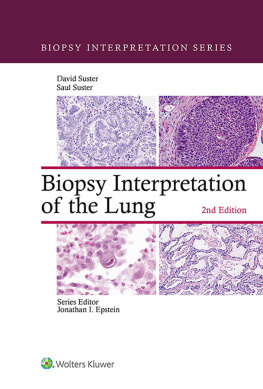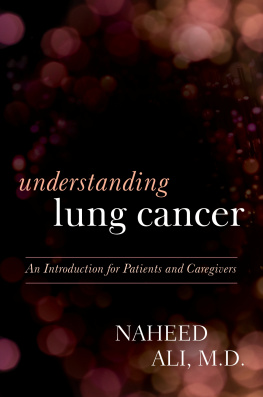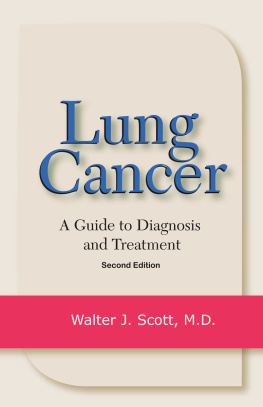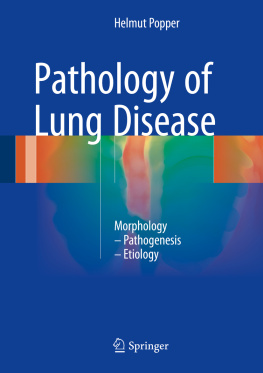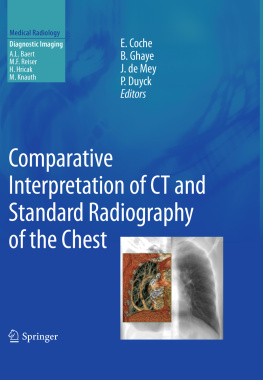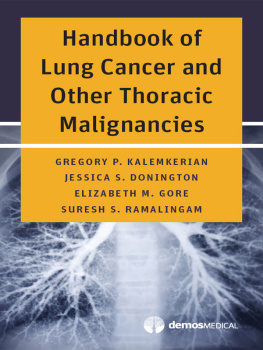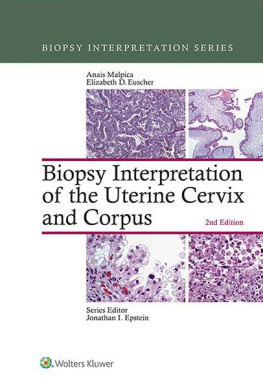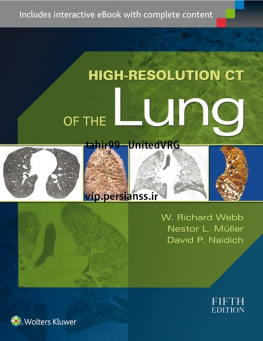Biopsy Interpretation Series
Biopsy Interpretation of the Lung
Second Edition
Biopsy Interpretation Series
Biopsy Interpretation of the Lung
Second Edition
David Ilan Suster, MD
Assistant Professor
Department of Pathology, Immunology, and Laboratory Medicine
Rutgers University, New Jersey Medical School
Newark, New Jersey
Saul Suster, MD
Professor and Chairman Emeritus
Department of Pathology
Medical College of Wisconsin
Milwaukee, Wisconsin

Acquisitions Editor: Nicole Dernoski
Development Editor: Ariel S. Winter
Editorial Coordinator: Anthony Gonzalez
Editorial Assistant: Maribeth Wood
Marketing Manager: Phyllis Hitner
Production Project Manager: Kirstin Johnson
Design Coordinator: Joseph Clark
Manufacturing Coordinator: Beth Welsh
Prepress Vendor: S4Carlisle Publishing Services
Second edition
Copyright 2021 Wolters Kluwer.
Copyright 2013 Lippincott Williams & Wilkins, a Wolters Kluwer business. All rights reserved. This book is protected by copyright. No part of this book may be reproduced or transmitted in any form or by any means, including as photocopies or scanned-in or other electronic copies, or utilized by any information storage and retrieval system without written permission from the copyright owner, except for brief quotations embodied in critical articles and reviews. Materials appearing in this book prepared by individuals as part of their official duties as U.S. government employees are not covered by the above-mentioned copyright. To request permission, please contact Wolters Kluwer at Two Commerce Square, 2001 Market Street, Philadelphia, PA 19103, via email at permissions@lww.com, or via our website at shop.lww.com (products and services).
9 8 7 6 5 4 3 2 1
Printed in China
Library of Congress Cataloging-in-Publication Data
Names: Suster, Saul, author. | Suster, David Ilan, author.
Title: Biopsy interpretation of the lung / David Ilan Suster, Saul Suster.
Other titles: Biopsy interpretation series.
Description: 2nd edition. | Philadelphia: Wolters Kluwer Health, [2021] | Series: Biopsy interpretation series | Saul Susters name appears first in the previous edition. | Includes bibliographical references and index.
Identifiers: LCCN 2020009050 | ISBN 9781975136581 (hardback) | eISBN: 9781975136604
Subjects: MESH: Lung Diseasespathology | Biopsymethods
Classification: LCC RC734.B56 | NLM WF 600 | DDC 616.2/40758dc23
LC record available at https://lccn.loc.gov/2020009050
This work is provided as is, and the publisher disclaims any and all warranties, express or implied, including any warranties as to accuracy, comprehensiveness, or currency of the content of this work.
This work is no substitute for individual patient assessment based upon healthcare professionals examination of each patient and consideration of, among other things, age, weight, gender, current or prior medical conditions, medication history, laboratory data and other factors unique to the patient. The publisher does not provide medical advice or guidance and this work is merely a reference tool. Healthcare professionals, and not the publisher, are solely responsible for the use of this work including all medical judgments and for any resulting diagnosis and treatments.
Given continuous, rapid advances in medical science and health information, independent professional verification of medical diagnoses, indications, appropriate pharmaceutical selections and dosages, and treatment options should be made and healthcare professionals should consult a variety of sources. When prescribing medication, healthcare professionals are advised to consult the product information sheet (the manufacturers package insert) accompanying each drug to verify, among other things, conditions of use, warnings and side effects and identify any changes in dosage schedule or contraindications, particularly if the medication to be administered is new, infrequently used or has a narrow therapeutic range. To the maximum extent permitted under applicable law, no responsibility is assumed by the publisher for any injury and/or damage to persons or property, as a matter of products liability, negligence law or otherwise, or from any reference to or use by any person of this work.
shop.lww.com
Dedication
To my family for their endless support on this journey.
D.I.S.
To my wife, Jenny, and to our children, David and Dana.
S.S.
Preface
Lung biopsies represent some of the most common types of specimens seen by pathologists during routine daily practice. The small size of the biopsies and frequent artifactual changes induced by the procedure, however, can create serious challenges for the pathologist. Despite the limitations, small lung biopsy specimens can provide valuable information that will be of importance for the clinician in patient management and treatment.
This book aims to address the various aspects of lung biopsy interpretation. Although there are numerous excellent textbooks of pulmonary pathology in print, most are based on the pathology of resected specimens and very few address the particular challenges and special limitations of small lung biopsies. This book is organized by traditional disease groups and covers the major clinical aspects of the various disease processes, plus histopathologic features and use of ancillary diagnostic techniques such as special stains, immunohistochemistry, and molecular pathology. The indications for the various types of biopsies (i.e., endoscopic vs. core needle vs. open/wedge biopsy) are discussed in the context of the various lesions.
This second edition of Biopsy Interpretation of the Lung has been necessitated by the many advances that have taken place in recent years in our understanding of lung pathology. Numerous changes in terminology, diagnostic criteria, and the development of newer molecular techniques have modified the practice of pulmonary pathology. This edition incorporates updated information regarding the role of molecular pathology in the evaluation of lung biopsies. The references in this edition have been thoroughly updated with the inclusion of over 400 new references encompassing new terminology, updated diagnostic criteria, and molecular advances for various entities. Over 500 color photomicrographs as well as over 100 additional online images are included to help illustrate various pulmonary diseases. More than 30 tables are provided to categorize lesions and present diagnostic criteria in a simple format. In addition, care has been taken to incorporate the current standard terminology adopted by the World Health Organization with their current criteria and definitions alongside our approach to certain tumors. We hope this second edition will expand and improve on some of the areas in the previous edition and will continue so serve as a helpful source of consultation for practicing pathologists as well as pathology residents and fellows.
David Ilan Suster, MD
Saul Suster, MD
Contents
Methods for Obtaining Lung Biopsies
Lung biopsies represent an important and often definitive method for establishing a diagnosis in patients afflicted with pulmonary disorders. Three basic methods are currently routinely employed for the evaluation of lung tissue: endoscopic biopsies, transthoracic (percutaneous) core needle biopsies, and video-assisted thoracoscopic surgery (VATS) lung biopsy. The older method of open lung biopsy via thoracotomy was associated with significant morbidity and has been largely abandoned in favor of VATS. Techniques based on the cytologic examinations of specimens obtained through fine needle aspiration (FNA) or bronchial brushings and washings also play a role in the evaluation of patients with lung disorders but will not be a subject of discussion in this book. The selection of the biopsy method employed will be dictated by the clinical circumstances and the level of experience and skill of the thoracic surgeon, pneumonologist, or interventional radiologist. Obviously, the diagnostic yield for a focalized endobronchial lesion will be much higher on endobronchial biopsy than for a diffuse or peripheral lung process. Diffuse lung diseases with predominant peribronchial distribution such as sarcoidosis are particularly amenable to diagnosis on transbronchial biopsy. Conditions in which diagnostic features depend on demonstration of temporal heterogeneity and variations in the histopathologic features from site to site, such as idiopathic interstitial pneumonias, will require a VATS approach and will yield only extremely limited results on endoscopic biopsies. Correlation of the clinical information and radiographic findings is indispensable for a correct interpretation. It is important that the pathologist be provided with a full clinical history, results of imaging studies, and other clinical test results, as well as a provisional or suspected differential diagnosis by the surgeon or clinician at the time the biopsy specimen is submitted.

